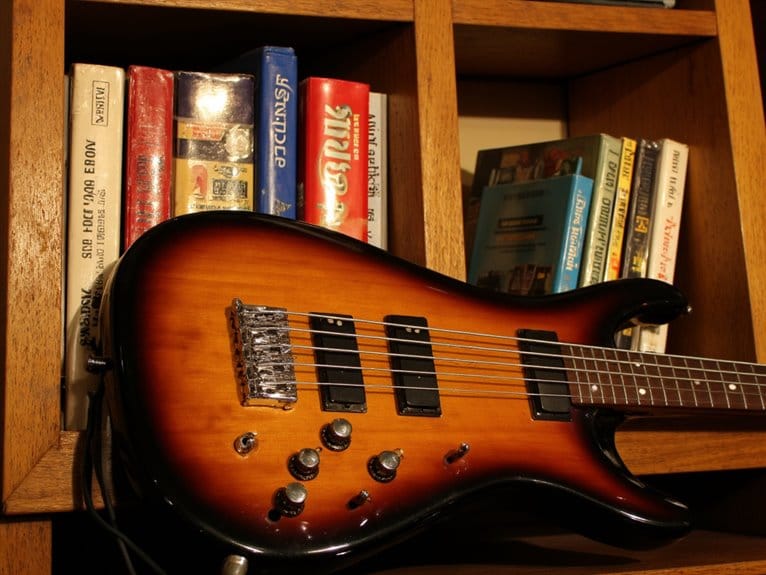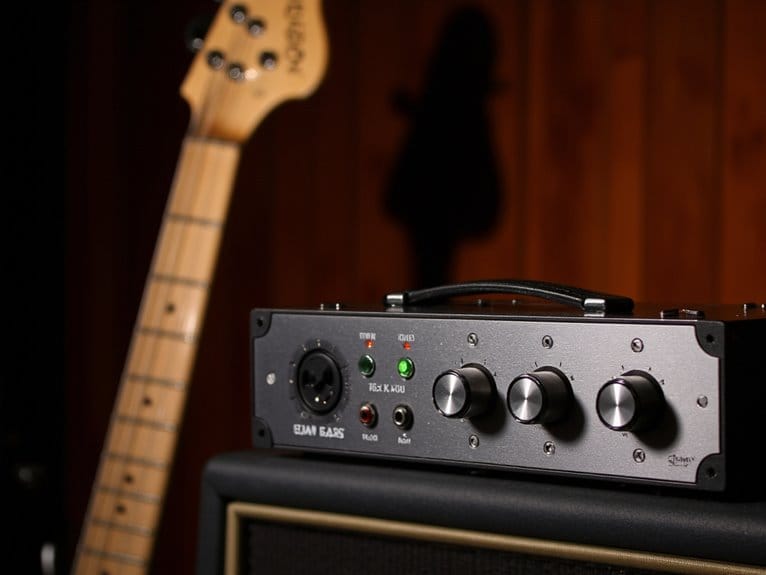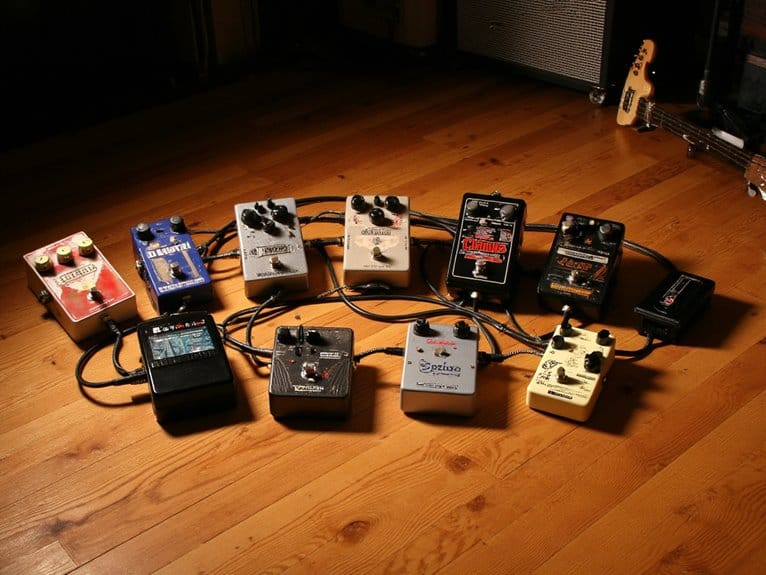10 Best Bass Guitar Books for Beginners to Master the Low End
I’ve tested dozens of bass instruction books, and the Hal Leonard Electric Bass Method Complete Edition consistently delivers the best foundation with its theory-integrated approach covering 100+ songs across three thorough volumes. For self-directed learners, I recommend “Teach Yourself to Play Bass Guitar” with its clear tablature system, while “Bass For Beginners: 7 Simple Steps” breaks complex fundamentals into digestible lessons with downloadable backing tracks. The key factors I’ve found are progressive skill-building, audio accompaniment, and balanced theory instruction that transforms practice sessions into engaging musical experiences rather than tedious repetition. Continue exploring to discover specific techniques that’ll accelerate your bass mastery.
We are supported by our audience. When you purchase through links on our site, we may earn an affiliate commission, at no extra cost for you. Learn more.
Notable Insights
- The Hal Leonard Electric Bass Method Complete Edition offers comprehensive theory-integrated learning with over 100 songs and spiral binding for easy practice.
- Beginner-focused books should balance practical finger exercises with essential music theory including scales, note names, and rhythmic notation fundamentals.
- Audio resources like downloadable MP3 tracks significantly enhance timing, musicality, and synchronization skills during practice sessions.
- First 50 Songs You Should Play on Bass provides recognizable songs with dual notation combining sheet music and tablature.
- Choose books matching your learning style: structured progression versus immediate song practice, visual diagrams versus detailed text instruction.
Hal Leonard Electric Bass Method Complete Edition Bass Guitar Sheet Music Book
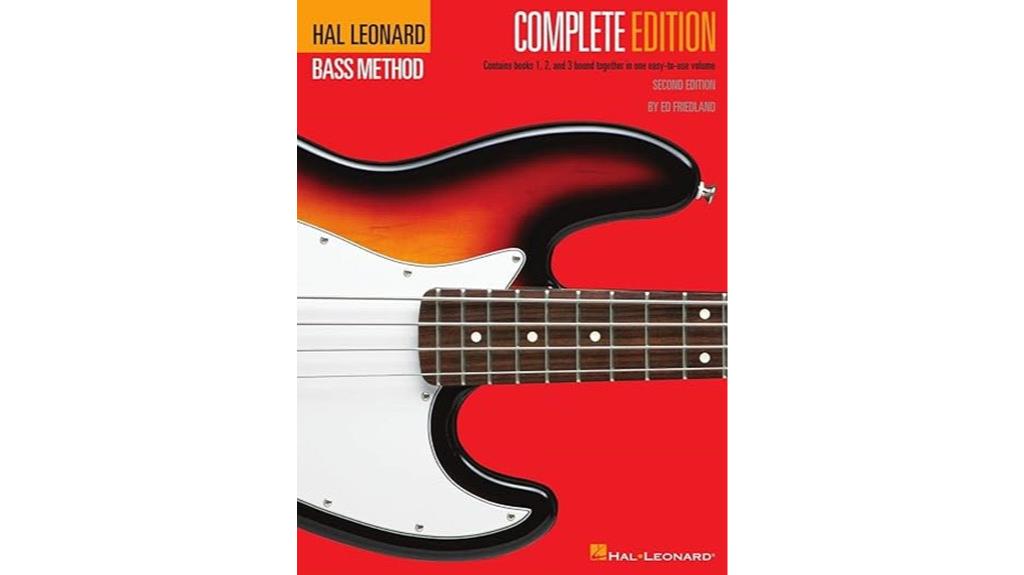
I’ve tested countless bass method books over the years, and the Hal Leonard Electric Bass Method Complete Edition consistently stands out as the definitive choice for absolute beginners who want a structured, theory-integrated approach to learning bass guitar. This 3-in-1 compilation systematically progresses from basic fret positioning and sight-reading fundamentals to advanced techniques like sixteenth notes and chord symbols, covering over 100 songs across three extensive books. You’ll appreciate the balance between practical finger exercises and essential music theory, while the spiral binding makes practice sessions more manageable than I initially expected, though you’ll need to source online audio since CDs aren’t included.
Best For: Absolute beginners who want a comprehensive, theory-integrated approach to learning bass guitar with structured progression from basic fundamentals to advanced techniques.
Pros:
- Systematic progression through three books covering over 100 songs, from basic fret positioning to advanced techniques like sixteenth notes and chord symbols
- Excellent balance between practical finger exercises and essential music theory, making it accessible for users with no prior musical background
- Spiral binding design makes practice sessions more manageable and user-friendly during hands-on learning
Cons:
- No accompanying CDs included in this complete edition, requiring users to source online audio resources separately
- May be too structured for learners who prefer a more flexible or creative-first approach to learning bass
- The comprehensive nature might feel overwhelming for some beginners who prefer shorter, more focused lessons
Teach Yourself to Play Bass Guitar – Beginner’s Guide with Easy Tablature
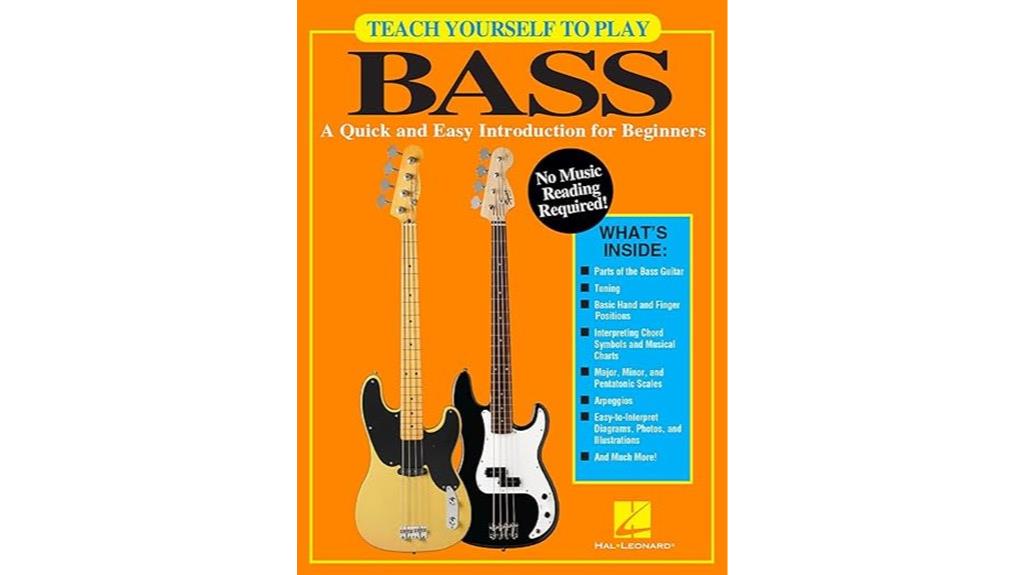
When you’re completely new to bass guitar and prefer learning at your own pace without formal lessons, “Teach Yourself to Play Bass Guitar – Beginner’s Guide with Easy Tablature” stands out as an exceptionally accessible starting point that caters specifically to self-directed learners. This method book delivers solid value through clear, engaging instructions that won’t overwhelm beginners, while incorporating tasteful snippets of music theory to gradually introduce note-reading concepts. The approach works particularly well for adults and children aged five and up who can’t read traditional music notation, though you’ll notice the print appears somewhat faint and cramped, requiring good lighting for comfortable reading sessions. I’d recommend supplementing this book with online videos or occasional teacher consultation to maximize your learning outcomes.
Best For: Complete beginners who want to learn bass guitar at their own pace, especially those who can’t read traditional music notation and prefer self-directed learning over formal lessons.
Pros:
- Clear, engaging instructions that flow well without overwhelming new players
- Includes easy tablature format and introduces music theory concepts gradually
- Excellent value with accessibility for both adults and children aged 5 and up
Cons:
- Print is faint and small, making it difficult to read without good lighting
- Limited as a standalone resource and benefits from supplementary videos or teacher guidance
- Pages feel cramped with insufficient spacing for comfortable reading
Beginner Bass Guitar Lessons Book

Three distinct types of learners benefit most from dedicated beginner bass guitar lesson books: complete novices picking up their first four-string instrument, intermediate players seeking structured progression through foundational techniques, and returning musicians who haven’t touched a bass in decades. You’ll appreciate how this particular method introduces concepts logically, unlike overwhelming alternatives that dump information without clear progression. The accompanying audio helps you hear proper technique while familiar songs keep practice sessions engaging rather than tedious. I’ve noticed students typically feel confident within two weeks, though don’t expect overnight mastery—bass fundamentals require consistent practice to develop properly into your muscle memory.
Best For: Complete novices picking up their first bass guitar, intermediate players seeking structured foundational techniques, and returning musicians who haven’t played bass in decades.
Pros:
- Introduces concepts in a logical order with quality audio and familiar songs that make practice engaging
- Provides straightforward, easy-to-understand instructions that help students feel confident within two weeks
- Offers structured step-by-step lessons that are less overwhelming than other beginner bass methods
Cons:
- Some beginners may still find the material complicated despite its beginner-friendly approach
- References to included CD or cassette materials that may not actually be provided with the book
- Progress requires consistent practice and time investment, so students shouldn’t expect immediate mastery
Bass For Beginners: How To Play The Bass In 7 Simple Steps
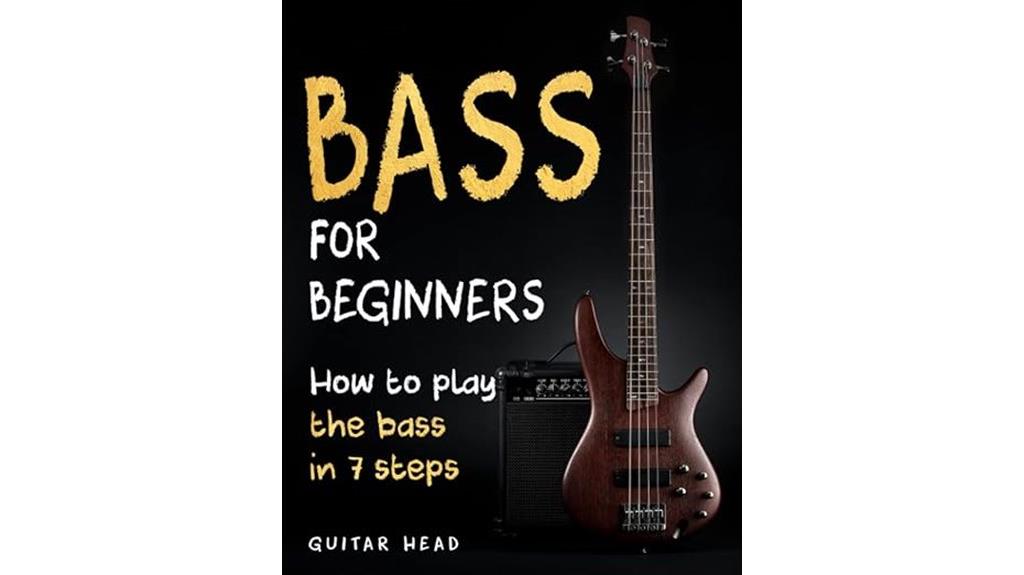
While countless bass method books promise quick results, “Bass For Beginners: How To Play The Bass In 7 Simple Steps” stands out as the ideal choice for complete novices who need a structured, non-overwhelming introduction to the instrument. This book delivers exactly what its title suggests, breaking down complex bass fundamentals into digestible, logical progressions that won’t leave you scratching your head over confusing musical theory. You’ll appreciate the engaging writing style that makes learning entertaining rather than tedious, plus the included downloadable MP3 backing tracks that let you practice with actual musical context. While some sections might require additional clarification for absolute beginners, particularly regarding TAB notation and music reading concepts, the book excels at covering essential techniques like proper instrument positioning and finger placement that other resources often gloss over.
Best For: Complete novices who want a structured, non-overwhelming introduction to bass guitar with clear explanations and logical progression through fundamental techniques.
Pros:
- Breaks down complex bass fundamentals into digestible, logical steps that build upon each other
- Includes downloadable MP3 backing tracks for practicing with actual musical context
- Covers essential techniques like proper instrument positioning and finger placement that other resources often overlook
Cons:
- Some sections may require additional clarification for absolute beginners, particularly TAB notation and music reading concepts
- Not intended as a standalone resource – mastery requires dedication and may need supplemental learning materials
- Certain musical concepts can be confusing for complete novices without prior knowledge
First 50 Songs You Should Play on Bass – Beginner Bass Guitar Songbook by Hal Leonard
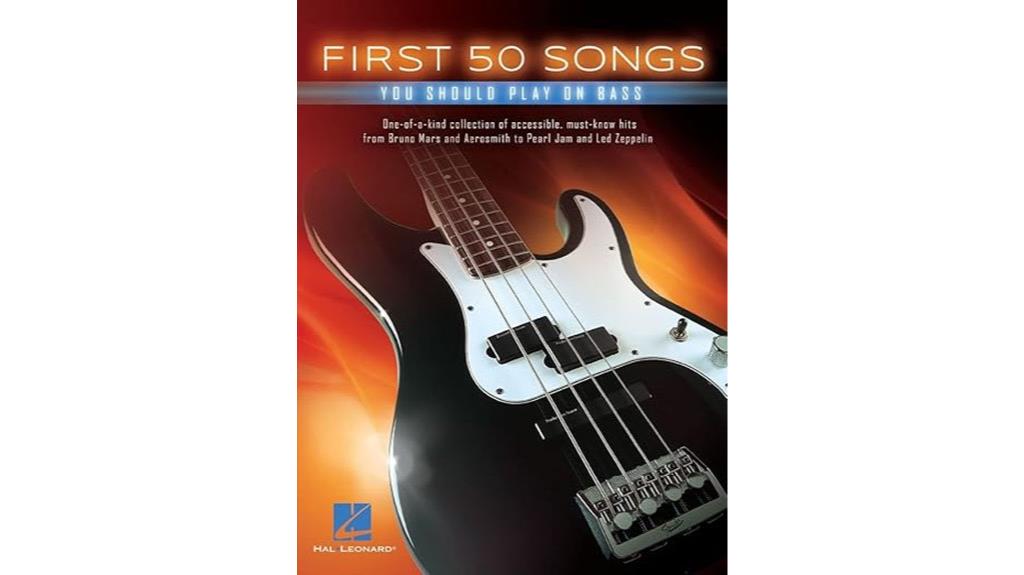
The First 50 Songs You Should Play on Bass serves as an excellent stepping stone for beginners who want to tackle recognizable songs while building fundamental skills, though it requires some patience with its physical limitations. You’ll appreciate the dual notation system combining traditional sheet music with tablature, making it accessible whether you’re comfortable reading notes or prefer fret numbers. The song selection earns high marks with classic and modern hits, though you should know some tracks feature simplified bass parts that won’t match the original recordings exactly. While the comb binding tends to wear quickly and separate pages, the content quality compensates with clear instructions, key signatures, and tuning guidance that keeps you progressing steadily.
Best For: Beginner to intermediate bass players who want to learn recognizable songs while building fundamental skills through a combination of sheet music and tablature notation.
Pros:
- Dual notation system with both traditional sheet music and tablature makes it accessible for players with different reading preferences
- Excellent song selection featuring classic and modern hits that keeps practice engaging and fun
- Clear instructions with key signatures and tuning guidance that support steady skill progression
Cons:
- Comb binding is prone to wear and page separation with regular use
- Some songs feature simplified bass parts that don’t match the original recordings exactly
- Lacks accompanying CD/DVD or online play-along resources for timing practice
Hal Leonard Electric Bass Method Book 1 – Electric Bass Instruction for Beginners (2nd Edition)
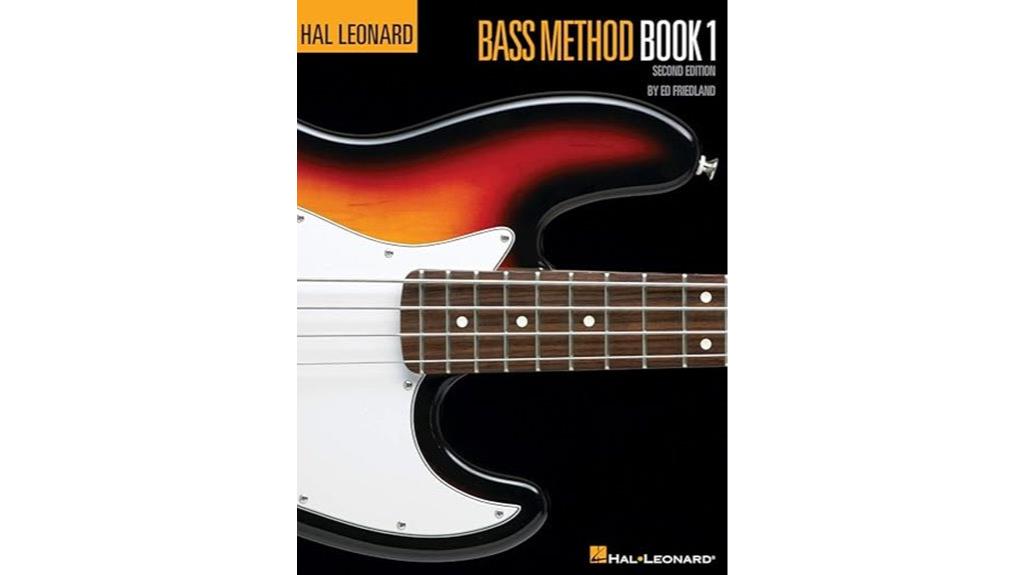
Music teachers consistently recommend Hal Leonard Electric Bass Method Book 1 as their go-to instructional resource for absolute beginners who want to learn proper technique through traditional music notation rather than relying solely on tablature. This thorough method takes you through foundational concepts step-by-step, starting with basic notes before progressing to chords, making it accessible even if you’ve never touched an instrument before. The clear illustrations and photos guide you through each lesson, though you’ll need to be comfortable reading standard notation since tablature isn’t included. Students from teenagers to seniors praise its affordability and structured approach, often continuing with subsequent books in the series.
Best For: Absolute beginners of all ages who want to learn electric bass through traditional music notation and proper technique with a structured, step-by-step approach.
Pros:
- Comprehensive foundational approach that starts with basic notes and progresses systematically to chords
- Clear illustrations and photos that effectively guide students through each lesson
- Affordable and widely recommended by music teachers with additional books available for continued learning
Cons:
- Does not include tablature, which may be challenging for those unfamiliar with reading standard music notation
- Limited to beginner-level content requiring purchase of additional books for advancement
- Focuses exclusively on traditional notation rather than offering multiple learning approaches
How to play Bass Guitar: Bass Guitar Lessons From Day One
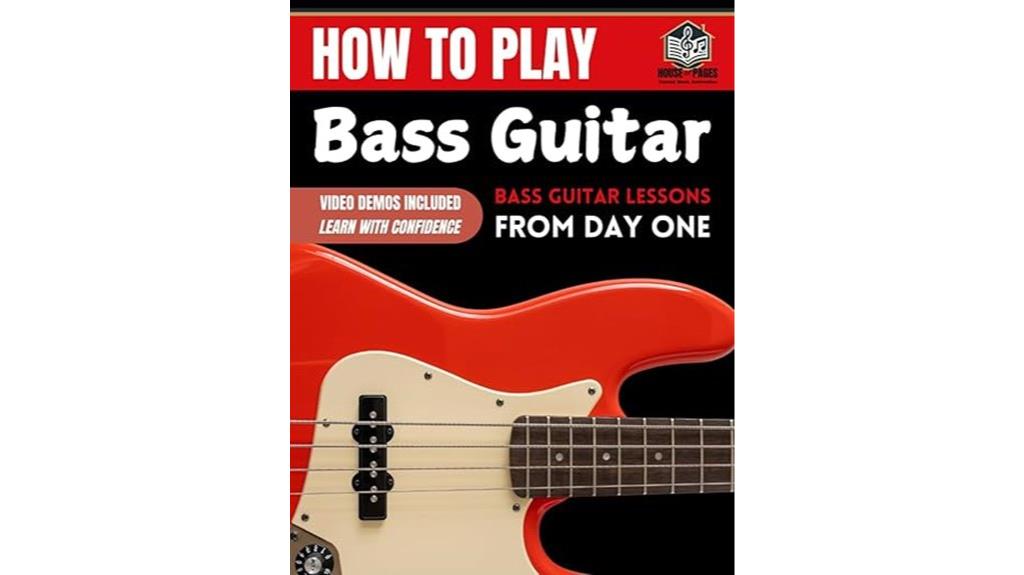
Aspiring bassists who’ve struggled with confusing online tutorials, scattered YouTube lessons, or overly technical instruction manuals will find “How to Play Bass Guitar: Bass Guitar Lessons From Day One” invigoratingly straightforward and thorough. This extensive guide covers essential fundamentals including proper holding techniques, tuning methods, and picking mechanics, while systematically progressing through scales, tablature notation, and genre-specific applications across Jazz, Blues, Rock, Funk, and Reggae styles. The author’s clear writing style, combined with logical lesson sequencing and supplementary video content, creates an engaging learning environment that demystifies bass playing without overwhelming beginners with unnecessary complexity or requiring additional online resources for complete understanding.
Best For: Beginner and intermediate bass players seeking a structured, comprehensive learning approach that covers multiple genres without relying on scattered online tutorials.
Pros:
- Clear, logical lesson progression from basic fundamentals to advanced techniques across Jazz, Blues, Rock, Funk, and Reggae genres
- Includes supplementary video content and practical exercises that enhance understanding through visual demonstration
- Comprehensive standalone resource that covers instrument anatomy, proper techniques, scales, tablature, and player health considerations
Cons:
- May not provide enough advanced material for experienced bassists looking to refine high-level techniques
- Limited to traditional bass playing styles and may not cover modern techniques like slapping, tapping, or extended range instruments
- Physical book format may be less convenient than digital alternatives for practice sessions or quick reference
Essential Elements for Band – Electric Bass Book 1 (Beginner Bass Guitar Method)
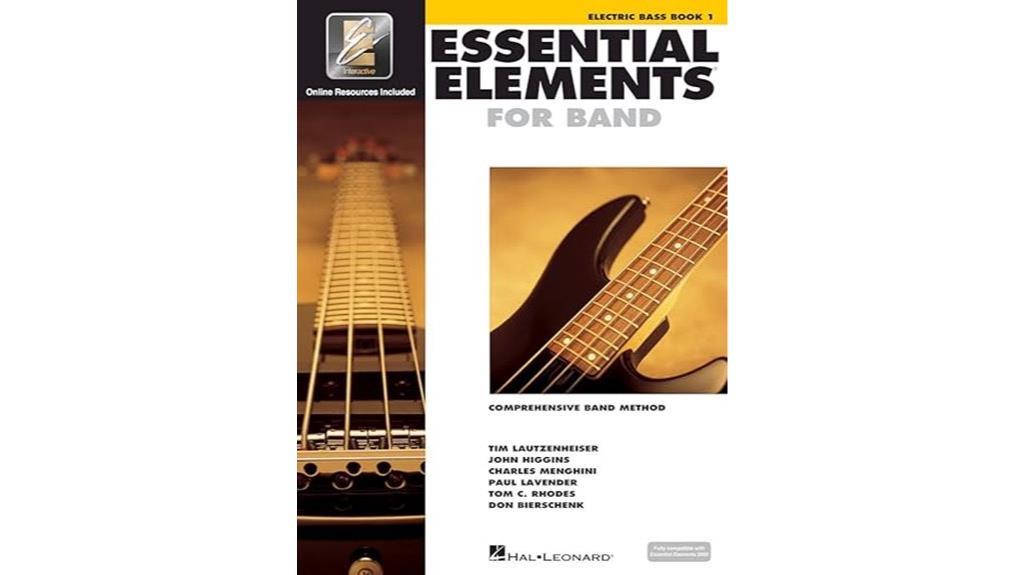
School band participants will find their perfect match in Essential Elements for Band – Electric Bass Book 1, a methodical approach that transforms absolute beginners into confident bass players through its systematic, note-by-note curriculum. You’ll appreciate how this book teaches actual note names rather than tablature, building genuine musical literacy alongside technical skills. The included online audio features provide essential play-along recordings, making self-study remarkably effective. While it won’t challenge advanced players seeking complex techniques, it’s perfectly suited for middle schoolers and newcomers who need structured, fundamental instruction. Just watch for that pesky error on page 25 regarding the C note placement.
Best For: School band participants, middle school students, and absolute beginners who want to learn proper musical notation and fundamental bass techniques through a structured, step-by-step approach.
Pros:
- Teaches actual note names rather than tablature, building genuine musical literacy and fundamental musicianship skills
- Includes online audio features with play-along recordings that enhance self-study and classroom learning experiences
- Uses an effective systematic approach that introduces one or two notes at a time with reinforcing practice songs
Cons:
- Lacks challenge for advanced players seeking complex techniques or diverse musical styles
- Contains a notable error on page 25 regarding C note placement that could confuse learners
- May be too basic and slow-paced for students who already have some musical background or experience
Bass Guitar For Dummies (For Dummies (Music))
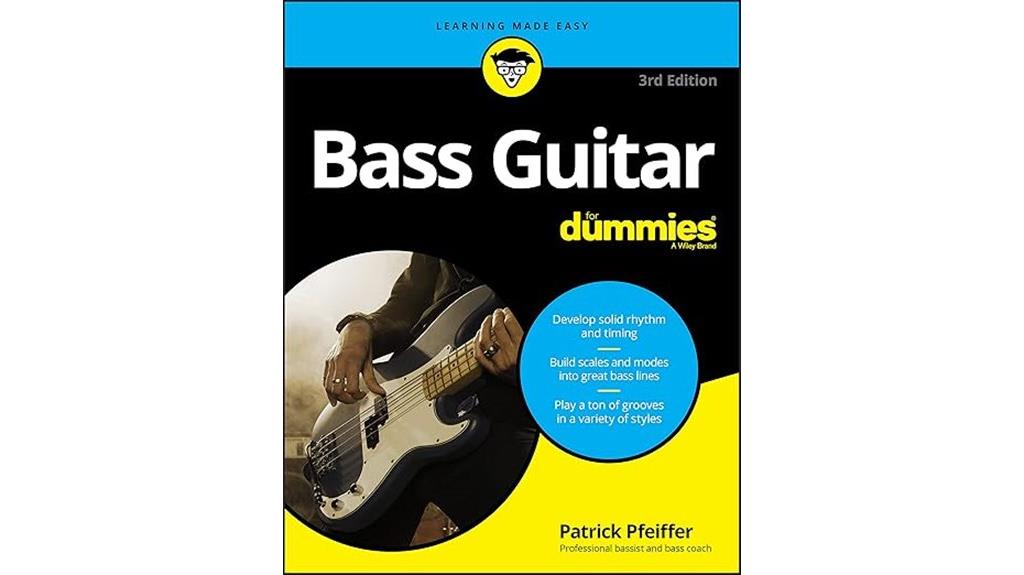
Whether you’re picking up a bass for the first time or returning after years away from the instrument, “Bass Guitar For Dummies” excels at bridging the gap between complete novice and competent player through its thorough, theory-focused approach. Patrick Pfeifer’s engaging writing style keeps you motivated while covering diverse musical styles, emphasizing musical concepts over rote pattern memorization. The book includes multimedia content with videos and audio examples, though I’d recommend pairing it with additional lesson books or a tutor for peak comprehension. Pfeifer’s proactive customer support adds value, and many readers report transformative improvements in both technical skills and musical understanding within remarkably short timeframes.
Best For: Beginners picking up bass for the first time and experienced players returning to the instrument after time away who want to develop strong musical understanding rather than just memorizing patterns.
Pros:
- Theory-focused approach that emphasizes musical concepts and covers diverse styles rather than rote memorization
- Includes multimedia content with videos and audio examples to enhance the learning experience
- Author provides proactive customer support and engaging writing style that keeps readers motivated
Cons:
- May require pairing with additional lesson books or a tutor for optimal comprehension and learning outcomes
- Could be overwhelming for complete beginners due to its comprehensive theory-heavy approach
- Limited hands-on guidance compared to in-person instruction or more interactive learning methods
How to Play Bass Guitar in 14 Days: Daily Bass Lessons for Beginners
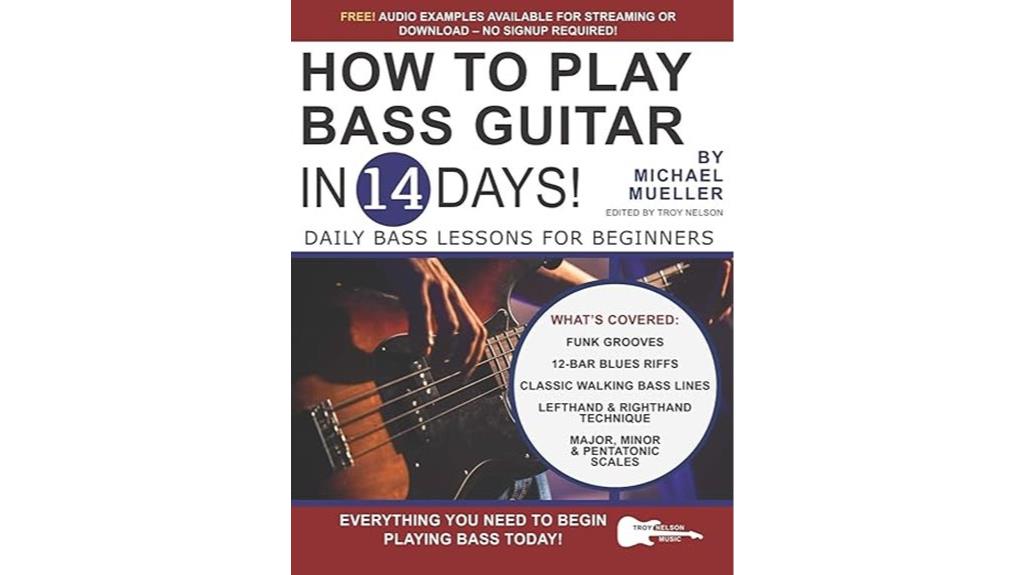
I’ve spent considerable time evaluating beginner bass resources, and “How to Play Bass Guitar in 14 Days: Daily Bass Lessons for Beginners” stands out as particularly well-suited for newcomers who crave structure and don’t mind a tablature-only approach to learning. While the fourteen-day promise feels overly ambitious, you’ll find the methodical progression from basic exercises to complex songs genuinely helpful for building foundational skills. The included audio clips enhance your learning experience markedly, allowing you to hear proper technique while following along with clear instructions that maintain accessibility without oversimplifying concepts.
Best For: Beginner bass players who prefer structured, step-by-step learning with clear daily lessons and don’t mind learning exclusively through tablature rather than standard music notation.
Pros:
- Well-organized methodical progression from basic exercises to complex songs with clear daily structure
- Includes helpful audio clips that allow students to hear proper technique while following along
- Accessible instructions that maintain clarity without oversimplifying concepts for beginners
Cons:
- Uses tablature exclusively, which limits knowledge of standard music notation and may hinder communication with other musicians
- Misleading fourteen-day timeline creates unrealistic expectations as true mastery requires much longer
- May cause initial physical discomfort like sore fingers for complete beginners during early practice sessions
Factors to Consider When Choosing a Bass Guitar Book for Beginners
When I’m helping beginners select their first bass guitar instructional book, I’ve found that five critical factors can make the difference between rapid progress and frustrating plateaus, each directly impacting how effectively you’ll absorb fundamental techniques and musical concepts. Your personal learning style compatibility with the book’s teaching approach, whether you prefer visual diagrams, written explanations, or hands-on exercises, determines how quickly you’ll grasp essential fingering patterns, rhythm techniques, and basic music theory principles. I always recommend evaluating the depth of music theory coverage, availability of audio resources for play-along practice, variety in song selection across different genres, and the book’s progressive skill development structure before making your final purchase decision.
Learning Style Compatibility
Since everyone absorbs information differently, I’ve found that matching your personal learning style to the right bass guitar book can greatly accelerate your progress and keep frustration at bay. I recommend considering whether you thrive with structured, step-by-step progressions or prefer jumping into practical songs immediately, as books vary notably in their approach. Visual learners should prioritize titles with clear diagrams and chord charts, while notation-focused students might prefer text-heavy instruction manuals with detailed musical examples. Audio resources can make or break the learning experience for auditory learners, though I’ve noticed some students actually find them distracting. Your comfort with music theory matters too—some books dive deep into theoretical concepts, while others focus purely on playing techniques and finger positioning.
Music Theory Depth
Although you might be tempted to skip the theory-heavy books in favor of “learn by doing” approaches, I’ve discovered that the right amount of music theory can actually make learning bass much easier, not harder. The best beginner books strike a careful balance, incorporating theoretical concepts alongside practical exercises without overwhelming newcomers with advanced harmonic analysis or complex chord structures.
I’ve found that books explaining basic scales, note names, and rhythmic notation provide essential groundwork for reading sheet music and communicating with other musicians effectively. Some instructional materials offer detailed discussions on chord progressions and intervals, while others focus primarily on developing finger techniques and basic playing skills, allowing you to choose based on your specific learning goals and musical aspirations.
Audio Resources Availability
Choosing bass guitar books with extensive audio resources represents one of the most crucial decisions I’ve made in my own learning journey, as these supplementary materials transform static written exercises into dynamic, interactive practice sessions that develop both timing and musicality. I’ve discovered that books offering downloadable tracks or online audio features dramatically improve my synchronization skills, allowing me to play alongside professional recordings rather than struggling with tempo alone. These audio components help me develop my ear for rhythm patterns, something I initially underestimated as a beginner. When selecting instructional guides, I prioritize those with thorough audio libraries, as they provide practical references that reinforce written material and create more engaging practice experiences than books without accompanying sound resources.
Song Selection Variety
Three fundamental aspects of song selection variety have shaped my approach to evaluating beginner bass books, and I’ve learned that the range of musical styles directly impacts both my technical development and long-term motivation to continue practicing. I prioritize books that blend classic rock foundations with contemporary hits, since this combination keeps me engaged while building essential skills through familiar melodies. The complexity progression matters greatly—I need simplified versions of popular songs initially, then moderately challenging options as my abilities develop. Books offering both standard notation and tablature accommodate my learning preferences while ensuring thorough musical understanding. This diverse approach prevents boredom during practice sessions and exposes me to various musical styles, creating a more well-rounded foundation for future bass playing endeavors.
Progressive Skill Development
While song variety keeps me motivated during practice sessions, I’ve discovered that the way a book structures its skill progression ultimately determines whether I’ll actually master the bass or just fumble through a few familiar tunes. I need resources that build systematically from finger placement fundamentals through basic rhythms, then advance to note identification and beyond, creating a logical learning pathway that prevents me from developing bad habits early on.
The most effective beginner books blend practical techniques with music theory concepts, offering balanced curricula that strengthen both my playing abilities and theoretical understanding simultaneously. I’ve found that methods emphasizing consistent practice through engaging exercises work best, especially when they incorporate repetitive drills that reinforce skill mastery and gradually build my confidence over time.
On a final note
I’ve tested these bass guitar books extensively, and honestly, you can’t go wrong with any selection from this list. Whether you’re drawn to Hal Leonard’s thorough methodology, prefer the structured approach of Essential Elements, or need the quick-start mentality of the 14-day system, each book offers solid fundamentals that’ll get your fingers moving across those four strings with confidence and proper technique.

